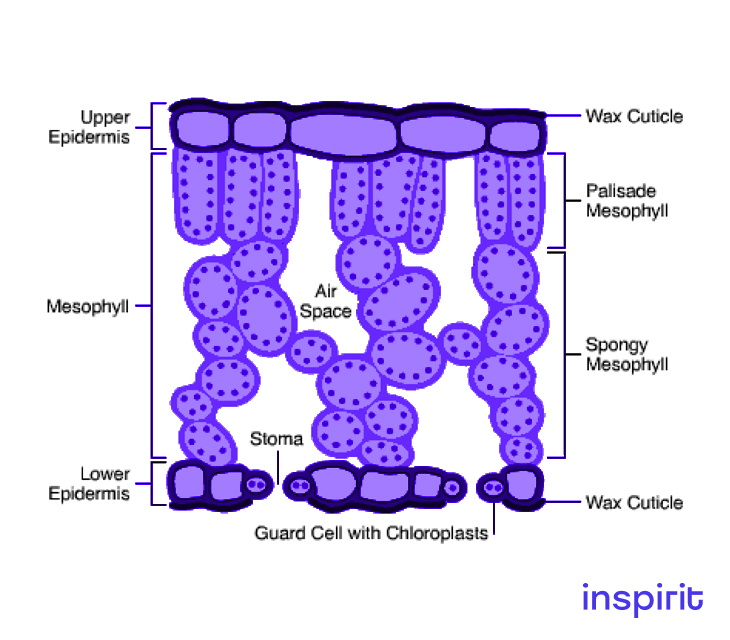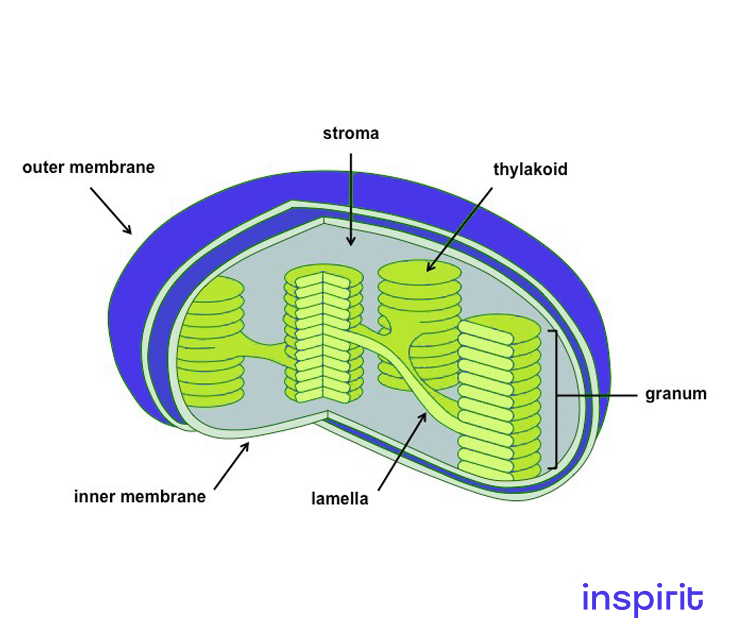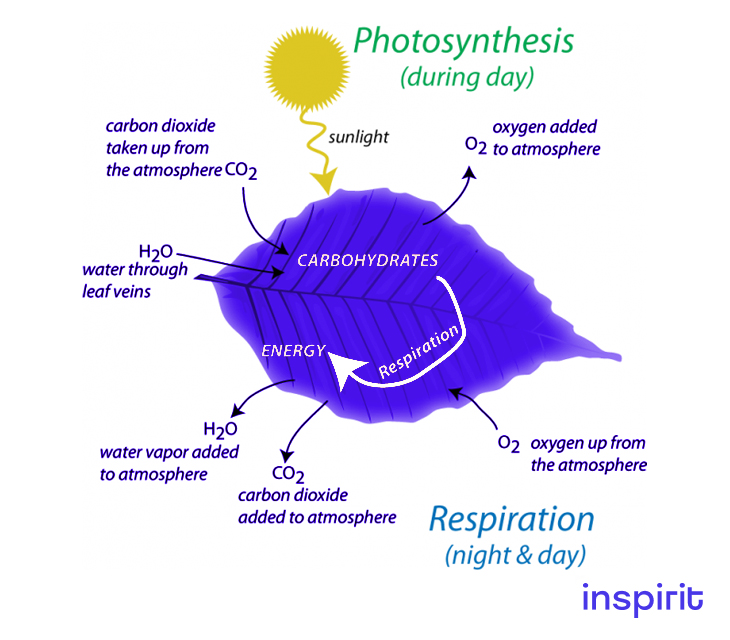Role of Leaves in Photosynthesis Study Guide
Introduction
All living beings require energy to grow and live. This energy is received from the food that we eat. Animals depend on external food sources to meet the daily quota of energy. On the contrary, plants can prepare their own food, and are thus capable of producing their own energy. The process by which plants make their food is known as photosynthesis. The entire process of photosynthesis occurs inside the leaves, and hence leaves are called the powerhouse of plants.
What is photosynthesis?
The process by which green plants utilize solar energy to convert carbon dioxide absorbed from the atmosphere and water from the soil into glucose (plant food) in the presence of green-colored pigment (chlorophyll) is known as photosynthesis. Special structures present in the leaves help in the completion of this process. Leaves act as a photosynthetic unit. They are the most adapted and well-suited organs of the plants for photosynthesis because of the following reasons:
- Leaves contain chlorophyll-containing cells, called chloroplasts.
- It contains stomata that help in the exchange of gases.
- Because of their wide surface, it facilitates easy and more capture of solar energy.
Diagram of a leaf

Components in leaves facilitate photosynthesis
Highly specific functional structures that help in the process of photosynthesis are listed below:
- Epidermis
- Stomata
- Mesophyll tissue
- Veins
Epidermis
- The primary component maintaining the structural integrity of a leaf is the epidermis.
- It is also responsible for the secretion of a waxy substance called the cuticle, which prevents an excess evaporation rate.
- A tightly packed layer of epidermal cells lies on both the upper and lower surface of leaves.
- Lying on this epidermal layer are minute microscopic openings called the stomata (singular., stoma).
Stomata
- Stomata are small openings present across a leaf, predominantly found on the lower surface, and play a crucial role in photosynthesis and other plant life processes.
- These stomata are guarded by two bean-shaped cells, called guard cells.
- The inner walls of these guard cells are comparatively thicker than their outer walls.
- These stomata and guard cells act as a passage for easy diffusion of gases needed for photosynthesis.
Role of guard cells in opening and closing of stomata:
- Water is absorbed from the soil with the help of root hair cells.
- This absorbed water gets transported to the leaves for photosynthesis.
- Absorption of water also leads to the turgid (swollen) condition of the guard cells, due to which the guard cells bulge out, opening the stomata.
- The opposite mechanism takes place when water evaporates from the leaves’ surface. These guard cells turn flaccid, and their walls retract and lead to the closing of stomata.
This repeated contraction and relaxation of guard cells is responsible for controlling the opening and closing of stomata. Thus, guard cells help monitor the amount of gaseous exchange occurring in the plant body.
Mesophyll tissues
Underlying the epidermis lies special tissues, called the mesophyll tissues. These tissues are usually of two types, palisade and spongy parenchyma. Chloroplasts are special cell organelles found in green plants, within these parenchymatous tissues. These chloroplasts are so named because they contain a special green-colored pigment called chlorophyll, an important pigment needed for photosynthesis.
Structure of chloroplast

- Double membraned organelles, found in leaves and other green regions of a plant body.
- The chloroplast’s inner membrane is folded into disc-shaped structures called thylakoids, which contain the green pigment chlorophyll.
- Thylakoids are arranged in the stack to form grana (singular., granum).Numerous such stacks are connected and remain embedded on a gel-like matrix, called the stroma.
Veins
- Each leaf contains a large network of veins and is widely named xylem and phloem. The main purpose of the xylem is to carry absorbed water to its designated location to conduction photosynthesis.
- On the contrary, phloem helps move prepared food material from the leaves to other regions of the body.
Process of photosynthesis in leaves

Light-dependent phase
This process takes place inside each thylakoid of the chloroplasts. As the name suggests, sunlight plays an important role during this phase. Thus it is sometimes referred to as the photochemical phase. The light-dependent phase takes place over two steps, which are as follows:
Step 1: Activation of chlorophyllThe chlorophyll present inside thylakoids gets exposed to sunlight and gets activated.
Step 2: The splitting of waterActivated chlorophyll leads to the breakdown of water molecules into its two components, hydrogen, and oxygen. This process of splitting water in the presence of energy is termed as photolysis (photo= light, lysis= breaking) of water. Photolysis of water takes place in the grana of a chloroplast.
Light independent phase or dark phaseThis reaction is independent of solar energy, occurs simultaneously with light-dependent reactions, and occurs in the stroma of the chloroplast. The main property of this phase is the conversion of produced glucose molecules to starch, which is stored in plant parts. Starch acts as an energy source during emergent conditions.
Importance of leaf
- Conducts photosynthesis and maintains energy sources in plants.
- Maintains carbon dioxide and oxygen balance in the atmosphere.
Conclusion:
Several internal factors determine the rate of photosynthesis. These are as follows:
- Amount of chlorophyll present.
- Properly hydrated protoplasm helps in a stable rate of photosynthesis. Leaved, therefore, plays a very crucial role in the process of photosynthesis.
- Structure of leaf. The numbers of stomata, the thickness of cuticle, size of leaf lamina play a crucial role in the rate of photosynthesis.
FAQs
1. What is the role of leaves in photosynthesis?
The broad surface area of leaves allows for enhanced absorption of sunlight. Moreover, numerous pores, called stomata, allow easy gaseous exchange. Therefore, leaves act as the primary location for photosynthesis.
2. What are the 3 main functions of a leaf?
- Production of food through photosynthesis.
- Gaseous exchange between plant body and atmosphere.
- Maintenance of water levels in plant body through evaporation.
3. What is the role of leaf and chloroplast in photosynthesis?
Chloroplasts are special chlorophyll-containing cells present inside a leaf. Green colour pigment chlorophyll is very important for absorbing solar energy and, therefore, in photosynthesis processes.
4. Which part of a plant is primarily responsible for photosynthesis?
Photosynthesis primarily occurs inside a leaf of a plant.
5. Where does photosynthesis take place in a leaf?
Photosynthesis takes place inside the chloroplast of the leaf.
6. What do plants need for photosynthesis?
- Carbon dioxide
- Water
- Light energy
- Chlorophyll
- Optimum temperature
7. Why are plants green in color?
Green-colored pigment present inside the chloroplast of leaves is responsible for the green coloration of leaves.
We hope you enjoyed studying this lesson and learned something cool about Role of Leaves in Photosynthesis! Join our Discord community to get any questions you may have answered and to engage with other students just like you! Don’t forget to download our App to experience our fun, VR classrooms – we promise, it makes studying much more fun! 😎
]]>